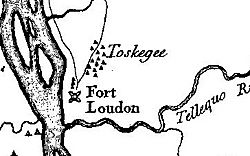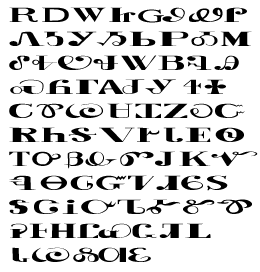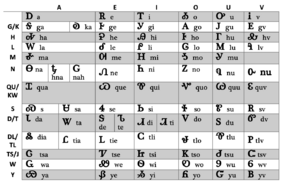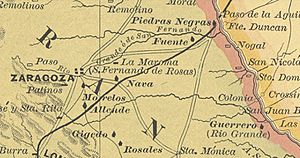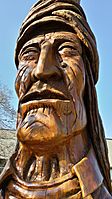Sequoyah facts for kids
Quick facts for kids
Sequoyah
|
|
|---|---|
| ᏍᏏᏉᏯ | |
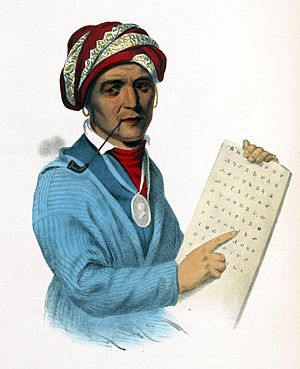
SE-QUO-YAH – a lithograph from History of the Indian Tribes of North America. This lithograph is from the portrait painted by Charles Bird King in 1828.
|
|
| Born | c. 1770 |
| Died | August 1843 (aged 72–73) San Fernando de Rosa, Coahuila, Mexico (near present day Zaragoza, Coahuila, Mexico)
|
| Nationality | Cherokee, American |
| Other names | George Guess, George Gist |
| Occupation | Silversmith, blacksmith, educator, warrior, politician, inventor, linguist |
| Spouse(s) |
Sally Benge
(m. 1815) |
| Children | 2 |
Sequoyah (Cherokee: ᏍᏏᏉᏯ, Ssiquoya, or ᏎᏉᏯ, Se-quo-ya; around 1770 – August 1843), also known as George Gist or George Guess, was a very talented Native American from the Cherokee Nation. He was skilled in many different areas, like a scientist, artist, and inventor all rolled into one!
In 1821, Sequoyah finished creating the Cherokee syllabary. This was a special writing system that made it possible for the Cherokee people to read and write in their own language. It was amazing because he was one of the few people in history from a group without a written language to invent a successful one. His invention helped the Cherokee become one of the first Native American groups in North America to have a written language. Sequoyah also represented the Cherokee Nation in important meetings, like signing treaties about land.
The Cherokee people quickly saw how useful his syllabary was. They started using it a lot and officially adopted it in 1825. It helped unite the Cherokee Nation, giving them new ways to talk to each other and a stronger sense of independence. By the 1850s, almost all Cherokee people could read and write, which was even better than many of their European-American neighbors.
Sequoyah's syllabary also inspired people around the world. It is believed to have led to the creation of 21 other writing systems, used for 65 languages in North America, Africa, and Asia.
Contents
Sequoyah's Early Life and Family
There are different stories about Sequoyah's early life. This is because there are not many old documents about him. Some stories were passed down by word of mouth, but they sometimes disagree.
Sequoyah was born in a Cherokee town called Tuskegee, in Tennessee, around 1778. A famous historian named James Mooney said that Sequoyah spent his early years with his mother. In the Cherokee culture, children belonged to their mother's family. Her male relatives were very important in raising them.
His name, Sequoyah, might come from the Cherokee word siqua, which means 'hog'. Some say it refers to a childhood injury that left him with a disability. A descendant said his birth name was 'Gi sqwa ya', meaning 'there’s a bird inside'. Later, his name was changed to Sequoyah, meaning 'there’s a pig inside', because he struggled with farm work.
Sequoyah's mother, Wut-teh, was likely related to important Cherokee chiefs like Old Tassel and Doublehead. Because of Cherokee customs, Sequoyah learned everything from his mother, including the Cherokee language and how to be a tradesman.
People are not sure who Sequoyah's father was. Some say he was a fur trader from Virginia named Nathaniel Guyst. Others believe he was a German peddler named George Gist. Another idea is that his father was Nathaniel Gist, who worked with George Washington. The Cherokee Phoenix newspaper said in 1828 that Sequoyah's father was part white.
No matter who his father was, he was not around when Sequoyah was born. Sequoyah had no brothers or sisters, and his mother raised him by herself. He never went to school and only spoke Cherokee. As a young boy, he helped his mother with cattle and in their garden. His mother ran a trading post.
Sequoyah became lame, meaning he had trouble walking, when he was young. No one knows exactly how this happened. Some say it was from a battle, others from a hunting accident. Because of this, he could not be a farmer or a warrior.
Even without formal schooling, Sequoyah was very smart. As a child, he built things for their dairy house. As he met more white people, he learned to make jewelry. He became a skilled silversmith, making beautiful items from silver coins.
After his mother passed away, Sequoyah might have taken over her trading post. It became a place where Cherokee men would meet and talk. He also learned to be a blacksmith. He made his own tools and was very good at repairing and making iron items. His spurs and bridle bits, decorated with silver, were very popular.
Sequoyah noticed that white people used a written language. He believed this gave them an advantage because they could share knowledge and communicate easily. The Cherokee had to rely on memory. This made him want to create a written language for his people.
Around 1809, Sequoyah started working on what would become the Cherokee syllabary. He hoped it would unite the Cherokee Nation and make them more independent. In 2008, an archaeologist found carvings from the syllabary in a cave in Kentucky, dating back to 1808 or 1818.
Moving to Alabama
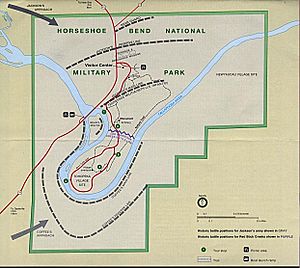
It is not clear exactly when Sequoyah moved from Tennessee to Alabama. Many Cherokee moved there because settlers were taking their land. Some say he moved with his mother around 1809, when he started working on the syllabary.
From 1813 to 1814, Sequoyah fought as a warrior in the Cherokee Regiment. They fought against the "Red Sticks," who were Creek warriors. During this time, he saw how difficult it was for his people not to have a written language. Unlike the white soldiers, he and his fellow Cherokee could not write letters home or read military orders. This made him even more determined to create a writing system. At first, some people thought his idea was like witchcraft.
In 1817, Sequoyah signed a treaty that exchanged Cherokee land in the southeast for land in Arkansas. But in 1819, he changed his mind about the treaty. This meant he lost his home in Alabama and had to move to Willstown (now Fort Payne), Alabama.
Life After the Syllabary's Creation
Sequoyah finished his syllabary around 1821. At first, the Cherokee Nation did not accept it. But once people saw how valuable it was, the syllabary quickly became popular. In 1824, the Cherokee National Council gave Sequoyah a medal. That same year, Sequoyah moved from Alabama to Arkansas.
Four years later, he reluctantly signed another treaty. This treaty exchanged Cherokee land in Arkansas for land in what is now Oklahoma. He was one of the Cherokee leaders who went to Washington, D.C., to sign this treaty.
In 1829, Sequoyah settled in what is now Sallisaw, Oklahoma, with his wife and daughter. In 1838, many Cherokees were forced to move to Oklahoma in a sad event called the Trail of Tears. After this, Sequoyah worked to unite different groups of Cherokees. In 1839, he helped sign the Act of Union, which created a new Cherokee constitution.
Soon after, Sequoyah traveled to Mexico. He hoped to find other Cherokees who had moved there. He wanted to teach them the syllabary and convince them to return to the Cherokee Nation in Oklahoma.
The Cherokee Syllabary and Its Impact
As a silversmith, Sequoyah often met European Americans. He was amazed by their writing, which he called "talking leaves." He saw that these papers allowed people to send messages over long distances. Most Cherokee people thought writing was magic or a special gift. Sequoyah did not believe this. He said he could invent a way for Cherokees to "talk on paper," even though his friends and family thought it was a silly idea.
How the Syllabary Was Created
Around 1809, Sequoyah began creating a writing system for the Cherokee language. At first, he tried to draw a picture or symbol for every word. His friends and neighbors worried about him because he was so focused on this work that he neglected his farm. His wife even burned some of his early work, thinking it was witchcraft. He soon realized that having a symbol for every word or idea would require too many pictures to remember.
Sequoyah's final idea was to create a symbol for each syllable in the language. A syllable is a part of a word, like "se-quo-yah." Using ideas from English, Greek, and Hebrew letters, he created 86 symbols by 1821. Later, this became 85 symbols. The syllabary is not an alphabet (where each letter is a sound), but a chart where each symbol stands for a consonant-vowel sound, or a syllable. The symbols are arranged in a chart, with columns for vowels and rows for consonants.
Teaching the Syllabary to Others
Sequoyah's six-year-old daughter, Ayokeh, was the first person to learn the syllabary. She helped him test it. News spread in their town that they had found a new way to communicate. The town chief even brought them to trial. Sequoyah and Ayokeh were separated, but they sent letters to each other using the new system. Eventually, the people realized that Sequoyah had indeed created a real way to communicate, and they all wanted to learn it.
He traveled to the Cherokee lands in Arkansas. When he tried to show the local leaders how useful the syllabary was, they doubted him. Sequoyah asked each leader to say a word, which he wrote down. Then, he called his daughter in to read the words back. This amazing demonstration convinced the leaders to let him teach the syllabary to more people. After a few months, Sequoyah wrote letters for his students to read, and they wrote back. This proved that his writing system worked.
When Sequoyah visited the eastern Cherokee tribes, he brought a sealed letter from an Arkansas Cherokee leader. By reading this letter, he convinced the eastern Cherokee to learn the system too. From there, it spread to all the Cherokee tribes and towns.
The syllabary was easy for the Cherokee people to learn. By 1830, about 90% of Cherokees could read and write in their own language. Over time, different dialects (ways of speaking) developed. The Eastern Dialect is spoken in North Carolina, and the Western Dialect is spoken in Oklahoma and North Carolina. A Southern dialect used to be spoken in South Carolina and Georgia, but it is no longer used.
Using the Syllabary in Print
In 1825, the Cherokee Nation officially adopted Sequoyah's writing system. The syllabary brought widespread reading and writing to the Cherokee Nation. They were one of the first Native American groups to have a working written language. By the end of 1825, the Bible and hymns were translated into Cherokee. In 1826, the Cherokee National Council asked people to translate and print their laws using Sequoyah's system.
In 1828, the Cherokee Phoenix newspaper, religious pamphlets, and legal documents were all printed using the syllabary. The Cherokee Phoenix was special because it was the first newspaper in North America to be printed in two languages: English and Cherokee. This newspaper helped keep the Cherokee Nation connected by giving them their own way to share news and information. The syllabary was used for over 100 years to create newspapers, books, religious texts, and calendars.
When the Cherokee Nation bought their first printing press, some of Sequoyah’s handwritten symbols needed to be changed. They were made clearer and adapted from the Roman alphabet for printing.
Sequoyah's Life in Indian Territory
After the Cherokee Nation accepted his syllabary in 1825, Sequoyah moved to the Cherokee lands in Arkansas. There, he opened a blacksmith shop and a salt works. He continued to teach the syllabary to anyone who wanted to learn.
In 1828, Sequoyah traveled to Washington, D.C.. He was part of a group trying to make a treaty for land in the new Indian Territory. While in Washington, D.C., he had his portrait painted by Charles Bird King. In the painting, he holds a copy of the syllabary. During his trip, he met leaders from other Native American tribes. This inspired him to try and create a writing system that all Native American tribes could use. He began traveling to areas like present-day Arizona and New Mexico to meet with tribes there.
In 1829, Sequoyah moved to a place called Big Skin Bayou. He built a cabin there, which became his home for the rest of his life. This cabin, Sequoyah's Cabin, was made a National Historic Landmark in 1965. The Oklahoma Historical Society managed it until the Cherokee Nation bought it in 2016.
In 1839, the Cherokee people were divided over being forced to move to Indian Territory. Sequoyah worked with another leader, Jesse Bushyhead, to try and reunite the Cherokee Nation. They spoke at a tribal meeting and convinced everyone to hold a new council to solve their problems. This led to the Act of Union and a new Cherokee Constitution.
Sequoyah's Last Journey and Death
Sequoyah dreamed of seeing the Cherokee Nation fully reunited. In the spring of 1842, he began a trip to find other Cherokee groups who were thought to have moved to Mexico. He wanted to convince them to return to the Cherokee Nation in Indian Territory. His son, Teesy, and other Cherokee men went with him.
He traveled to meet the Comanche Indians and then went into Northern Mexico. He even spent some time teaching Mexicans his native language.
Sequoyah died sometime between 1843 and 1845, likely from a breathing illness, during his trip to San Fernando de Rosas in Coahuila, Mexico. A letter written in 1845 by his companions said he died in 1843. The village of San Fernando de Rosas was later renamed Zaragoza.
In 1938, the Cherokee Nation's Chief, J. B. Milam, paid for a trip to find Sequoyah's grave in Mexico. They found a grave site near a spring in Coahuila, Mexico, but they could not be absolutely sure it was Sequoyah's.
In 2011, a newspaper article mentioned a discovery in 1903 of a grave site in the Wichita Mountains. Two men believed it was Sequoyah's grave. They said it was in a cave and contained a skeleton with one leg shorter than the other, along with a pipe, silver medals, a rifle, and an ax. However, this site was far north of the Mexican border.
Sequoyah's International Influence
Sequoyah's work had a big impact around the world. It encouraged people to create writing systems for other languages that did not have them yet. News of his syllabary spread throughout the United States. A missionary in Alaska read about it and created a syllabary for the Cree language. This inspired other Native groups in Canada to create writing systems for their languages.
A Cherokee person who moved to Liberia in Africa shared the story of his people's syllabary. This inspired a Bassa language speaker in Liberia to create his own syllabary. Other Native groups in West Africa followed this example.
A missionary in China read about the Cree syllabary and was inspired to create a writing system for a local Chinese language. Because of Sequoyah's work, a total of 21 known writing systems have been developed, used to write more than 65 languages.
Sequoyah's Legacy and Honors
Sequoyah's important contributions to Cherokee history are honored with statues, monuments, museums, and paintings across the United States.
- The giant redwood trees, called Sequoia sempervirens, are named after Sequoyah.
- The Sequoyah Birthplace Museum in Tennessee teaches about his life and Cherokee culture.
- In 1964, Sequoyah was added to the Hall of Great Westerners at the National Cowboy & Western Heritage Museum.
- Artist Henry Inman painted a portrait of Sequoyah around 1830. It is now in the United States National Portrait Gallery.
- Sequoyah is pictured on the back of the 2017 Sacagawea Dollar coin.
- Oklahoma gave a statue of Sequoyah to the National Statuary Hall Collection in 1917. This was the first statue of a Native American in the hall.
- A monument honoring Sequoyah was dedicated in September 1932 in Calhoun, Georgia.
- In 1939, a bronze panel featuring Sequoyah by Lee Lawrie was placed in his honor at the Library of Congress.
- A Sequoyah memorial is in front of the Cherokee Museum in North Carolina.
- Sequoyah's Cabin, where he lived from 1829 to 1844, was named a National Historic Landmark in 1965 in Oklahoma.
- On December 20, 1980, the United States Postal Service released a stamp in his honor.
- The composer Jack Kilpatrick wrote about Sequoyah: "Sequoyah was always in the wilderness. He walked about, but he was not a hunter. I wonder what he was looking for."
- Johnny Cash sang about Sequoyah in his 1964 song "The Talking Leaves".
In 1824, the Cherokee General Council gave Sequoyah a large silver medal. One side of the medal had his image and said, "Presented to George Gist by the General Council of the Cherokee for his ingenuity in the invention of the Cherokee Alphabet." The other side had two pipes and the same message in Cherokee. Sequoyah was said to wear this medal for the rest of his life, and it was buried with him.
-
Statue of Sequoyah in United States Capitol
-
Sequoyah Memorial in front of the Cherokee Museum in North Carolina
-
Bronze panel featuring Sequoyah (1939), by Lee Lawrie. Library of Congress John Adams Building, Washington, D.C.
-
Portrait of Sequoyah by Henry Inman, ca. 1830i n the National Portrait Gallery
Current Use of the Cherokee Language
Today, Cherokee is mainly spoken in Oklahoma, North Carolina, and Arkansas. Between 1,500 and 2,100 people actively speak Cherokee in these areas. A 2018 survey showed that most Cherokee speakers are over 40 years old.
In the Cherokee Nation (northeast Oklahoma), the syllabary is seen on street signs and buildings. It is an official language along with English and is taught in schools in Oklahoma and North Carolina. The Cherokee Nation is working to make the language a bigger part of daily life. Their goal is to have more fluent Cherokee speakers in the future by encouraging older members to teach younger generations and by increasing language programs in schools. People of all ages are learning the language, and it is offered at several universities.
During the time when Native American tribes were forced to leave their lands, known as the Trail of Tears, the use of the Cherokee language dropped a lot. In government-run Indian boarding schools, using any Native language could lead to physical punishment. In the late 20th century, there was a renewed interest in the Cherokee language, with programs run by the three main Cherokee tribes and online courses.
Places and Things Named After Sequoyah
- A small arrowhead found in the Midwest and South was named Sequoyah in 1968.
- The Sequoia trees in California were named Sequoia gigantea in 1847. It is believed this was in honor of Sequoyah.
- A chemical found in the needles of these trees was named sequoiene in 1880.
- The caterpillar of a moth was named Bembecia sequoiae.
- The area where Sequoyah lived in Oklahoma was renamed the Sequoyah District in 1851. When Oklahoma became a state, that area became Sequoyah County.
- The proposed State of Sequoyah was named in his honor.
- The Sequoyah Research Center collects and saves Native American writing and literature.
- Mount Sequoyah in the Great Smoky Mountains.
- Mount Sequoyah in Fayetteville, Arkansas.
- The Sequoyah Hills neighborhood in Knoxville, Tennessee.
- The Tennessee Valley Authority Sequoyah Nuclear Plant was named for him.
- The Sequoyah Marina on Norris Lake in Tennessee.
- The USS Sequoia was a yacht used by American presidents.
- Sequoyah Caverns and Ellis Homestead in Valley Head, Alabama.
- Sequoyah Country Club, Oakland, California.
- The Sequoyah Book Award is chosen annually by students in Oklahoma.
- Many schools are named after him, including:
- College of the Sequoias, Visalia, California
- Sequoyah High School (Georgia), Canton (Cherokee County), Georgia
- Sequoyah High School (Oklahoma), a Native American boarding school in Tahlequah, Oklahoma
- Sequoyah High School (Tennessee), Madisonville, Tennessee
- Sequoia High School (Redwood City, California)
- Sequoya Elementary School, Tahlequah, Oklahoma
- Sequoyah Elementary School, Shawnee, Oklahoma
- Sequoia Junior High School, Simi Valley, California
- Sequoyah Elementary School, Tulsa, Oklahoma
- Sequoia Elementary School, San Diego, California
- Sequoya Elementary School, Russellville, Arkansas
- Sequoya Middle School, Broken Arrow, Oklahoma
- Sequoya Elementary School, Derwood, Maryland
- Sequoyah School, Pasadena, California
See also
 In Spanish: Sequoyah para niños
In Spanish: Sequoyah para niños
- History of writing
- Bob Benge, Cherokee leader
- Old Tassel
- List of people who disappeared
- Hastings Shade (1941–2010), fifth-generation direct descendant of Sequoyah
- Tahlonteeskee (Cherokee chief)


